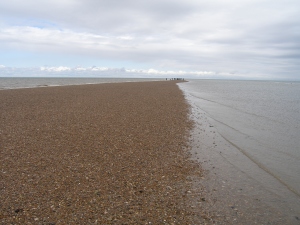Goodwin Sands

Despite the recommendation that the area should be designated a Marine Conservation Zone, protected from damaging operations, plans are afoot to dredge up to 2.5 million cubic metres of sand and gravel from the Goodwin Sands. This will be used in the new Dover Western Docks Revival scheme. We will be commenting on the eventual application, but in advance of that, Bryony has been in communication with the ecological consultants to voice our concerns and discuss what we feel should be included in the Environmental Impact Assessment.

We do not see how the removal of a huge amount of the sands for which the area was designated can fail to have a negative impact on the marine environment. Bryony and I went to a meeting at the Royal HaskoningDHV offices in London, to hear more about the work that has been done to assess the likely impact of the scheme on the underwater habitats. It is a huge challenge to survey the seabed in sufficient detail over such a large area, and to predict what will happen when this amount of sand and gravel is removed. The overview of the work was fascinating and it was useful to have the opportunity to request that particular concerns were covered in the Environmental Impact Assessment. We will be scrutinising this in due course.
Marine Planning
As yet, there is no real coordination of the many activities happening at sea around the Kent coast. This is about to change, and I went to an event in Whitstable to find out more.

The new marine plans are intended to guide what happens in the marine area, making sure activities take place at the right time and in the right place, says the Marine Management Organisation. Their aim is to enable sustainable economic growth whilst protecting the environment, balancing the needs of all. The meeting was to get input from interested people and organisations to help shape the plan for the South East marine area, from Felixstowe to Folkestone.

Although its overarching purpose is to enable sustainable growth, marine planning will provide us with a new way of influencing activity in the marine environment, providing advice and information to help identify where this could be best placed to avoid any damage.
Woolly Watery World

Staying with the marine theme, this week I press-ganged as many colleagues as possible to join a lunch-time session on crocheting a coral reef. Several years ago, at an event, a very interesting lady told me about the Crochet Coral Reef project.
This is a worldwide project which raises awareness of the plight of marine wildlife by getting people together to create amazing reef structures using crochet. I’ve had this in the back of my mind ever since, and now that we are working on the Guardians of the Deep project, I wondered if it would fit with the aims of that project, to involve people in understanding and looking after the marine environment.
So, on a rainy Easter afternoon, I persuaded my daughters that what they really wanted to do was to try crocheting or knitting some marine creatures, and took the results in to work to inspire colleagues to join in. Guided by Ruth, the Trust’s Queen of Crochet, we are going to test whether we can convincingly render the intricacies of Kent’s marine biodiversity in wool.